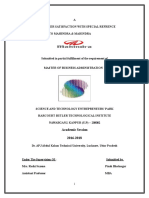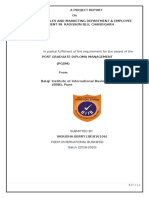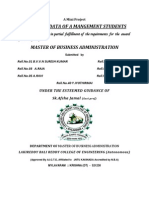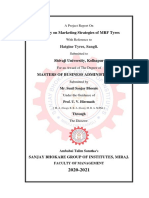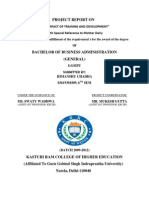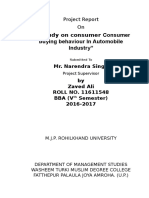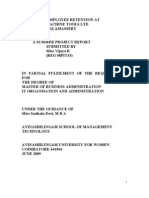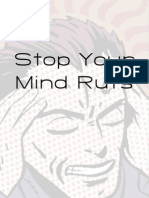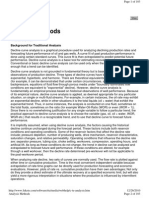Mini Project Mba
Mini Project Mba
Uploaded by
Tejaswini TejuCopyright:
Available Formats
Mini Project Mba
Mini Project Mba
Uploaded by
Tejaswini TejuOriginal Description:
Original Title
Copyright
Available Formats
Share this document
Did you find this document useful?
Is this content inappropriate?
Copyright:
Available Formats
Mini Project Mba
Mini Project Mba
Uploaded by
Tejaswini TejuCopyright:
Available Formats
An organization study at Muras Techno Casts
1.1 INTRODUCION TO INTERNSHIP
An INTERNSHIP is job training for white collar and professional careers.
Internships for professional careers are similar in some ways but not as rigorous
as apprenticeships for professions, trade and vocational jobs, but the lack of
standardization and oversight leaves the term open to broad interpretation. Interns may be
college or university students, high school students, or post-graduate adults. These
positions may be paid or unpaid and are usually temporary.
Generally, an internship consists of an exchange of services for experience between the
student and an organization. Students can also use an internship to determine if they have
an interest in a particular career, to create a network of contacts, to acquire
a recommendation letter to add to their curriculum vitae, or to gain school credit.
HOW LONG DO INTERNSHIPS LAST?
An intern works at a company for a fixed period of time, usually three to six
months. Some students will have a part-time internship in which they work at the office
for just a few days or hours per week.
Others will have full-time internships, meaning they work the same hours as the
company's full-time employees. Internships can be any time of the year, including over
the summer and during the regular quarter, trimester or semester.
WHY ARE INTERNSHIPS IMPORTANT?
Internships offer students a hands-on opportunity to work in their desired field. They
learn how their course of study applies to the real world and build a valuable experience
that makes them stronger candidates for jobs after graduation.
BNM INSTITUTE OF TECHNOLOGY Page 1
An organization study at Muras Techno Casts
WILL INTERNSHIP STUDENTS BE PAID?
Unpaid internships are common, but there are plenty of paid internships too. Whether or
not you will get a wage depends on your industry and role.
BUSINESS ADMINISTRATION INTERNSHIP OBJECTIVES
1. Apply business concepts and theories to real-world decision-making
2. Increase proficiency in specific business disciplines; such as human resources
management, operations management, marketing, accounting, statistics,
economics, finance, and business law.
3. Develop and improve business skills in communication, technology,
quantitative reasoning, and teamwork.
4. Observe and participate in business operations and decision-making.
5. Meet professional role models and potential mentors who can provide
guidance, feedback, and support.
6. Expand network of professional relationships and contacts.
7. Develop a solid work ethic and professional demeanor, as well as a
commitment to ethical conduct and social responsibility.
BNM INSTITUTE OF TECHNOLOGY Page 2
An organization study at Muras Techno Casts
1.2 INDUSTRY PROFILE
HISTORY
Investment casting is an industrial process based on lost-wax casting, one of the oldest
known metal-forming techniques. The term "lost-wax casting" can also refer to modern
investment casting processes.
Investment casting has been used in various forms for the last 5,000 years. In its earliest
forms, beeswax was used to form patterns necessary for the casting process. Today, more
advanced waxes, refractory materials and specialist alloys are typically used for making
patterns. Investment casting is valued for its ability to produce components with
accuracy, repeatability, versatility and integrity in a variety of metals and high-
performance alloys.
PRESENT SCENARIO OF FOUNDRY INDUSTRY
The foundry industry, also known as the casting industry, plays the role of a 'mother'
industry in India. It is a core industry producing cast metal components which serves as a
basic raw material for many sectors. Production of castings in India took a dip in 2008-09
due to the global economic crisis but has recovered strongly in 2010-11. Growth in the
industrial sector, post-recession, especially in manufacturing activities, has given a boost
to the foundry industry. According to the recent World Census of Castings by Modern
Castings, the Indian Foundry Industry is the second largest casting producer in the world,
producing around 9.05 million tonne of castings in 2010-11.
It is also one of the top ten countries in terms of average production of castings per plant.
In 2009, it was also the fastest growing top-10 nations increasing its casting tonnage by
9% over 2008. India currently has over 4,500 foundries in the small, medium and large
scale sectors with around 500 units having international quality accreditation.
BNM INSTITUTE OF TECHNOLOGY Page 3
An organization study at Muras Techno Casts
In India, the foundry industry is a major feeder to various other sectors and the
automobile sector accounts for almost one-third of the total market. Exports and imports
of castings have grown consistently in India, with export value being much higher than
imports. Foundry exports have grown by 48% in 2010-11 and have reached pre-recession
levels. USA accounts for one-fourth of the total exports from India, with Germany, UK,
South Africa, Italy and Canada being other major importers. Foundry imports have been
growing strongly over the years with almost one-third of the total being sourced from
China.
Germany, USA, Oman, Italy, Korea and Japan are the other prominent importers of
castings. Foundry units in India are mostly concentrated in clusters across various
regions. Maximum concentration of foundries is in Maharashtra, followed by West
Bengal, Tamil Nadu and Andhra Pradesh. The major foundry clusters include Batala &
Jalandhar in Punjab, Ahmedabad & Rajkot in Gujarat, Kolhapur in Maharashtra,
Belgaum in Karnataka, Coimbatore in Tamil Nadu, and Howrah in West Bengal.
The Indian economy has been performing well over the last few years and the trend is
likely to continue. The foundry industry will look to capitalize on this opportunity.
Growing demand from the automobile and engineering sectors coupled with supportive
government participation will drive the growth of the foundry industry in India.
Potential Market
Strongly growing automobile and auto components market in India has a high demand
for castings. Foundry market should look to develop as a hub for this sector and leverage
on it to increase production. Indian foundries should seek to expand their markets to
countries with insufficient supply of casting components. Foundries should establish
larger facilities and improve the quality of casting products to help develop the export
market for such goods.
A Vision Plan 2020, for the foundry industry has been initiated by The Institute of Indian
Foundry men (IIF) to recommend the needed initiatives for strong growth and emerge as
BNM INSTITUTE OF TECHNOLOGY Page 4
An organization study at Muras Techno Casts
a leading supplier of quality castings to the global market by 2020. The plan outlay is of
Rs 7.86 billion with an additional investment of Rs 5 billion through FDIs and Rs 8.48
billion through local resources. Vision plan will also help the industry to reach a level of
11.5 million ton per annum, take the total exports to around INR 16.4 trillion by 2020,
add 23 more established clusters and contribute towards the skill upgradation and training
of about 18,000 people.
For the time being, the foundry industry in India is poised for rapid growth in terms of
volumes, quality, management, efficiency and cost competitiveness. Resources need to be
pooled together to further the growth approach and make the casting business truly
global.
BNM INSTITUTE OF TECHNOLOGY Page 5
An organization study at Muras Techno Casts
COMPANY PROFILE
2.1 Background
Company name : Muras Techno Casts
Established : 2003
Industry : Foundry Industry
Address : Plot 136/A1, KIADB Industrial Area, Harohalli
2ndphase, kanakapura , Bengaluru-562112.
Plant size : 1.75 lakh sqft.
Certification : ISO 9001:2015
Website : www.murastech.com
Muras Techno Casts was established in the year 2013, its aim is to manufacture
premium quality investment castings, the company is managed by a group of well trained
professionals who have decades of experience and renowned technical experts, company
also in the field of creating precise investment castings. They say “quality does not mean
perfection in every step of the process, but creating a product of long-standing durability
as well”.
Muras Techno Casts is located in the Harohalli Industrial Area, created by the Karnataka
Industrial Areas Development Board (KIADB). Karnataka Industrial Areas Development
Board is one of the country's largest industrial areas, it is an ideal setting for Muras
Techno Casts to realize its vision of creating the best investment castings with full
passion.
BNM INSTITUTE OF TECHNOLOGY Page 6
An organization study at Muras Techno Casts
2.2 VISION, MISSION and QUALITY POLICY
Our Mission is to use the best machinery, on par with global standards, in order to
produce castings that are durable and long-lasting.
The Vision of Muras is to capture the global market through a spotless reputation
among our clients, and in the industry.
QUALITY POLICY
Objectives
With an eye for quality, Muras strives to achieve total customer satisfaction.
We engage in the continuous upgrading of our Quality Systems to stay up-to-date and
serve our customers in the most efficient manner possible.
There's always room to grow, and at Muras, we are always trying to improve by
adapting the latest technological advancements to reinforce our strong expertise in the
field.
Policy statement
Total consumer satisfaction will be achieved through constant contact with every
client, using feedback from internal and external entities to constantly improve
within the company.
Stringent measures will be taken to ensure continual upgrading of all systems and
processes to stay up-to-date with the latest technologies and help us serve our
clients better.
Continuous building of the skills of employees at all levels will be encouraged by
imparting need-based product, and system-related training.
BNM INSTITUTE OF TECHNOLOGY Page 7
An organization study at Muras Techno Casts
2.3 NATURE OF BUSINESS
Investment casting, also referred to as called "precision casting" or " lost-wax casting," is
one of the oldest and most well-known techniques of metal-forming. It allows for the
forming of precise components through the creation of castings which are created
especially for the manufacture of the specific component.
Castings aid in the production of multiple components of the same exact shape and
versatility, no matter how complex the structure of the component may be. This allows
for greater control in the production process, and reduced machining allowances. Thanks
to today's technological advancements, a plethora of materials can be used for the process
of investment casting, depending on the requirement of the component.
Investment casting, thus, is the most cost-effective solution for the creation of specialized
components of similar shape, no matter how intricate, to suit the conditions of their
usage. This allows for the establishment of the most appropriate component that
guarantees a more efficient process.
Advantages of investment casting:
1. Allows for the easy creation of complex components which are difficult to achieve
through other means
2. Casting of intricate forms with undercuts is possible
3. Almost any metal can be casted to suit various requirements and the usage of the
component
4. Durable and long-lasting, as it is especially made to carry out a particular task
5. High level of dimensional accuracy is achievable
6. Obtains a smooth surface finish, with no parting lines
7. Ready for use with little or no machining required
8. Certain 'unmachinable' parts can be casted to pre-planned shape
BNM INSTITUTE OF TECHNOLOGY Page 8
An organization study at Muras Techno Casts
METALS
Muras Techno Casts offers a variety of alloys to suit every need. Our expert engineers
will guide you by analyzing the best materials, and pick the one that best suits the
purpose. They include:
S.S-based Low alloy Cobalt-based Nickel-based Duplex steels
alloys grades alloys alloys
CF8 WCB Stellite CW2M CD4MC
CF8 WCC -6 CW6M UN
M IC102 Stellite CW12M A995 1B
CF3 0 -4 W CA6NM
CF3 IC104 Stellite CW6MC etc.
M 0 -3, etc. INCONEL
CN7 IC105 600
M 0 Monels,
HE, IC413 etc.
etc 0, etc.
IN-HOUSE TESTING
Chemical Testing Laboratory
Our chemical testing lab is equipped with Bruker spectrometers, of German make. They
work with all major metals bases, including Ni and Co. With the help of their dual optics
and clear sensor technology, we are able to scrutinize chemical composition with utmost
precision, which is indispensable to the process.
Physical Testing Laboratory
Universal Testing Machine (UTM)
BNM INSTITUTE OF TECHNOLOGY Page 9
An organization study at Muras Techno Casts
Hardness Testing Machine (HTM)
Metallurgical Microscope (Planned)
Non-Destructive Testing (NDT), radiography, and ultrasonic tests will be outsourced by
external agents in Bangalore. We also have an in-house testing facility of liquid penetrate
and magnetic particle.
A simulation method will be designed by expert personnel through the use of simulation
software by an external agency. This will help devise the most efficient methodology.
2.4 PRODUCT PROFILE
COOKWARE
ORTHO COMPONENTS
AUTOMOTIVE PARTS
VALVE / PUMP COMPONENTS
GEAR BOX COMPONENT
BNM INSTITUTE OF TECHNOLOGY Page 10
An organization study at Muras Techno Casts
COOKWARE ORTHO COMPONENTS
AUTOMOTIVE PARTS VALVE / PUMP COMPONENTS
GEAR BOX COMPONENTS
BNM INSTITUTE OF TECHNOLOGY Page 11
An organization study at Muras Techno Casts
2.5 OWNERSHIP PATTERN
Muras techno casts is a sole proprietor form of business organization founded by
Mr. Sagar Venkatesh with the help of managing director Mrs. Sudha Venkatesh.
2.6 FUTURE GROWTH AND PROSPECTS
Muras Techno Casts being a start up is intending to expand their business
in coming years and wants to see tremendous growth for their business in
the country.
As they are the only player in South India they want to acquire the whole
south Indian market and compete with the North Indian cluster by
exploring them as a major market player
BNM INSTITUTE OF TECHNOLOGY Page 12
An organization study at Muras Techno Casts
MC KINSEY’S 7S MODEL
McKinsey 7-s framework was developed in the
early 1980’s by Tom Peters and Robert
Waterman, two consultants working at the
McKinsey & Company Consulting firm; the
basic premise of the model is that there are
seven internal aspects of an organization that
need to be aligned if it is to be successful.The
model is most often used as an organizational
analysis tool to assess and monitor changes in
the internal situation of an organization.
The model is based on the theory that, for an organization to perform well, these seven
elements need to be aligned and mutually reinforcing. So, the model can be used to help
identify what needs to be realigned to improve performance, or to maintain alignment
(and performance) during other types of change.
The 7-s model can be used in a wide variety of situations where an alignment perspective
is useful, for example, to help you:
Improve the performance of the company.
Examine the likely effects of future changes within a company.
Align departments and processes during a merger or acquisition.
Determine how best to implement a proposed strategy.
The McKinsey 7-s model can be applied to elements of a term or a project as well. The
alignment issues apply, regardless of how you decide the scope of the areas you study.
BNM INSTITUTE OF TECHNOLOGY Page 13
An organization study at Muras Techno Casts
THE SEVEN ELEMENTS
The McKinsey 7-s model involves seven interdependent factors which are
categorized either “hard” or “soft” elements:
Hard Elements Soft Elements
Strategy Shared value
Structure Skills
Systems Style
Staff
“Hard” elements are easier to define or identify and management can directly
influence them. These are strategy statements; organization charts and reporting lines;
and formal processes and IT system.
“Soft” elements, on the other hand, can be more difficult to describe, and are less
tangible and more influenced by culture. However, these soft elements are as important
as the hard elements if the organization is going to be successful.
3.1 ORGANIZATIONAL STRUCTURE:
Structure represents the way business divisions and units are organized and include the
information of who is accountable to whom. In other words, structure is the
organizational chart of the firm. It is also one of the most visible and easy to change
elements of the framework.
In Muras Techno Casts, organizational structure is very simple, they have a line
organization structure which aptly suits to the nature of business. Administration controls
all the activities of other department. There is a person who is head of that particular
function and he will be supported by assistants.
BNM INSTITUTE OF TECHNOLOGY Page 14
An organization study at Muras Techno Casts
ORGANIZATION STRUCTURE OF MURAS TECHNO CASTS
MANAGING PARTNER
CEO
HOD MARKETING GM HOD PURCHASE
MARKETING EXECUTIVE PURCHASE EXECUTIVE
Production Manager HOD Quality HOD Admin
Inspectors
Maintenance Production
Manager In charge
Operators Operators
BNM INSTITUTE OF TECHNOLOGY Page 15
An organization study at Muras Techno Casts
MANAGING PARTNER / CEO /GM
Managing partner Mrs. Sudha Venkatesh is the head of the organization who deals with
framing policy, recruiting, supervising administration work in MTC. Mr.Sagar
Venkatesh, the CEO look over production, planning and other related activities.
RESPONSIBILITY AND AUTHORITY OF MANAGING PARTNER / CEO /GM
Has overall responsibility and is vested with authority for all activities of the
Organization.
Defines and documents the IMS Policy including Objectives and its commitment
for quality.
Overall development of the unit, with continual improvement.
Management reviews of Quality, Environmental, Health and safety System and
Internal Auditing.
Departments and Their Functions
Production
In Production there are two sub departments as shown below. Each sub department has
its unique role. Every sub department is controlled by respective head of that department.
PRODUCTION
MANAGER
MAINTANANCE PRODUCTION
MANAGER INCHARGE
OPERATORS OPERATORS
BNM INSTITUTE OF TECHNOLOGY Page 16
An organization study at Muras Techno Casts
RESPONSIBILITY AND AUTHORITY OF PRODUCTION MANAGER
Overall responsibility of the plant
General administration
Interaction with worker
Housekeeping activities
RESPONSIBILITY AND AUTHORITY OF MAINTENANCE MANAGER
Plan, schedule and execute daily maintenance & preventive maintenance of
machines and equipments
Maintain all relevant records of maintenance process
Manage and arrange for breakdown maintenance of machines and equipments if
any.
RESPONSIBILITY AND AUTHORITY OF OPERATORS
Carry out day-to-day production and related work assigned
Involvement in continual improvement activities (including housekeeping,
Kaizens, etc)
Cleaning and maintenance of machines, equipment, jigs & fixtures, tooling and
other production facilities.
PRODUCTION IN-CHARGE
Production in-charge co-ordinates the work of production manager and look over the
materials needed and the personnel who is involved in the production process and
maintains neat flow of production.
PURCHASE DEPARTMENT
Purchase department of MTC is concerned with purchasing raw materials on the basis of
the design of casting given by the clients. After receiving the design from clients the
production manager with the advice of CEO plans the casting and send quotations to the
BNM INSTITUTE OF TECHNOLOGY Page 17
An organization study at Muras Techno Casts
clients, once it is approved from clients the purchase manager plans for the raw materials
required to produce the components.MTC purchases materials from Ranchi , and some
materials from Bangalore.
RESPONSIBILITY AND AUTHORITY OF HOD PURCHASE
Planning and procuring materials as per material plan and specification /
requirement.
Supplier development, evaluation, selection and re-evaluation
Release and follow up of procurement schedules from suppliers.
Correspond and follow up for Corrective and preventive actions initiated if
any from supplier end.
Sending back the rejections to concerned suppliers.
RESPONSIBILITY AND AUTHORITY OF PURCHASE EXECUTIVE
Interacts with indenting departments for procurement of materials of required
quality and quantity in time.
Supplier listing, evaluation and rating.
Responsible for document & record control in his area of responsibility.
Responsible for Identification & Traceability in his area.
MARKETING DEPARTMENT
MTC follows internal marketing strategy. The marketing head will go and approach the
clients personally and get the orders for the company. The marketing department consists
of marketing head and a marketing executive
RESPONSIBILITY AND AUTHORITY OF HOD MARKETING
Responsible for Activities relating to Sales and Marketing activities.
Co-ordinates with customers.
Responsible for document & record control in his area of responsibility.
Responsible for Corrective and Preventive Actions
Responsible for Process Health Measure achievement
BNM INSTITUTE OF TECHNOLOGY Page 18
An organization study at Muras Techno Casts
RESPONSIBILITY AND AUTHORITY OF MARKETING EXECUTIVE
Generation of enquiries
Carryout contract review
Responsible for conducting customer satisfaction survey
Maintaining records in his area
QUALITY DEPARTMENT
The quality department consists of quality manager and quality inspectors, as and when
the production happens the quality manager checks for the quality of castings and ensures
it is as per the standards. MTC never compromise on quality, their main objective is to
provide quality castings their clients.
RESPONSIBILITY AND AUTHORITY OF HOD QUALITY
Reports to MD / DR
Responsible for inspection and testing of raw materials, components, in-
process items and finished Products for ensuring their conformity.
Preparation of Quality Plans and for identification and use of statistical
techniques.
Responsible for periodic calibration and control of all inspection, measuring
and test equipment.
Responsible for quality analysis and reporting and maintenance of Quality
Records.
RESPONSIBILITY AND AUTHORITY OF INSPECTORS
Inspection and disposition of raw materials, supplied items and in house items
Inspection and calibration of jigs, fixtures.
Preparation, revision and control of check lists for parts at receiving stage, in-
process & final inspection
Audit inspection of component
BNM INSTITUTE OF TECHNOLOGY Page 19
An organization study at Muras Techno Casts
ADMINISTRATION DEPARTMENT
Administration head is responsible for overall record maintenance and also looking over
accounts, documentation and other relate activities. HOD admin has to report to the MD
who looks over the company administration and accounts.
RESPONSIBILITY AND AUTHORITY OF HOD ADMIN
Responsible for activities relating to Personnel & Administrative functions.
Identification of Training Needs
Planning and Organizing Training Programmes.
Maintenance of training, education and qualification records.
Responsible for document & record control in his area of responsibility.
Responsible for Corrective and Preventive Actions in his Departments
Responsible for Process Health Measure achievement in his Departments
Responsible for Continual Improvement in his Departments.
4.2 SKILLS
MTC has established and maintained Procedure for Competence, Training and awareness
to identify the training needs for all employees & persons working for or on behalf the
organization in our company, performing tasks that have potential Significant Impact on
Health and safety in the work place.
At MTC all the employees have been imparted with / planned for appropriate training to
provide awareness with regard to
Importance of Conformance to the IMS, Procedures and other requirements of
Integrated Management System.
Significant Health hazards associated with their work and significant impacts
associated with the work.
BNM INSTITUTE OF TECHNOLOGY Page 20
An organization study at Muras Techno Casts
Roles & Responsibilities in achieving conformance with the IMS Policy and
Procedures and with the requirements of the Integrated Management System,
including Emergency Preparedness and Response requirements.
Potential consequences of departure from the documented procedures / Operational
Control procedures.
It is ensured that Personnel who perform tasks, which can cause Significant
Health hazards, are competent for the specified tasks. The competence is ensured
through appropriate education, training and / or experience.
Appropriate Training is provided to the Employees, Supplier & Contractor’s &
Persons working for or on behalf the organization, performing tasks that have
potential health hazards and develop their competence to avoid deviation of IMS
requirements at MTC. Training procedures take into account different levels of
responsibility, ability, literacy and risk
TRAINING PROCEDURE
Concerned Functional Heads identify need based / on-job training for employees
whose work may create significant impact on environment or significant risk
Training need is also identified by assessing the skill level of the employee as per
the skill matrix maintained by Concerned HOD’s
After needs are identified, information to be given to the employees through
concerned Department Heads through inter office memo or display through notice
board.
For each of the training conducted training course covered, date, trainer, training
attendance, training feedback and effectiveness are recorded
Personnel performing specific tasks / working in specific areas like Internal
Auditing are qualified on the basis of their relevant qualification / experience /
training and required on-job training (wherever necessary is provided).
Training program is conducted based on the personnel working in concerned area,
his understating ability, knowledge & skill including literacy.
BNM INSTITUTE OF TECHNOLOGY Page 21
An organization study at Muras Techno Casts
4.3 STRATEGY
Strategy is the plan of action an organization prepares in response to, or anticipation of,
changes in its external environment. Strategy is differentiated by tactics or operational
actions by its nature of being premeditated, well thought through and often practically
rehearsed.
The strategy used in Muras Techno Casts for production of castings are “push strategy”.
They produce castings as and when the company gets orders from their clients. They
don’t stock up materials or produce parts which are ready for sale because each client’s
necessity would be different; hence they also reduce the handling cost of materials.
4.4 STYLE / CULTURE:
Style represents the way the company is managed by top-level managers, how they
interact, what actions do they take and their symbolic value. In other words, it is the
management style of company’s leaders.
STYLE ON COMPANY’S PERSPECTIVE
Participative style of Management
In MTC they follow participative style of management which means the top
management involve the personnel and take their suggestion when taking
decisions and other activities of the company.
Top down approach
At the time of policy framing, the style flows from top to bottom. The policies
and other norms are communicated from the top management, all the policies and
staff related decisions are taken by the MD of the company.
BNM INSTITUTE OF TECHNOLOGY Page 22
An organization study at Muras Techno Casts
4.5 SYSTEMS
Every organization has some systems or internal processes to support and implement the
strategy and run day-to-day affairs.
MTC follow FIFO (First In First Out) method of inventory control that means the
raw materials purchased first are used first for the production.
HOD of each department assigns work to its departmental workers and they are
expected to do the same in the given time frame.
Top management takes the decisions and pass it on to the other employees.
4.6 STAFF
Staff element is concerned with what type and how many employees and organization
will need and how they will be recruited, trained, motivated and rewarded.
Employees are recruited by Managing partner of the company and they will be given
proper on the job training by their departmental heads employees are appraised for their
best work half yearly once.
The total number of employees in the company is 36, which is divided as follows
Types of employees Number
Skilled employees 10
Un skilled employees 7
Semi skilled employees 9
House keepers 4
Drivers 1
Security 2
BNM INSTITUTE OF TECHNOLOGY Page 23
An organization study at Muras Techno Casts
4.7 SHARED VALUES
Shared Values are at the core of McKinsey 7s model. They are the norms and standards
that guide employee behavior and company actions and thus, are the foundation of every
organization.
Quality policy
MTC follows strict quality policy, they do not compromise on quality and the employees
are expected to produce defect free goods
Environmental policy
Muras Techno Casts is committed to protect, conserve and restore our natural resources
and to conduct all our activities in an environmentally friendly manner. they will
continually improve our environmental performance
Occupational Health And Safety Policy
Muras Techno Casts aims to develop health and safety working systems by use of
proper and efficient methods in our operations with the aim of reducing occupational
health hazards & prevention of accidents and training at all levels for continual
improvement in performance of occupational health and safety management systems.
BNM INSTITUTE OF TECHNOLOGY Page 24
An organization study at Muras Techno Casts
SWOT ANALYSIS
Background & History of the SWOT Analysis
The origins of the SWOT analysis technique is credited by Albert Humphrey, who led a
research project at Stanford University in the 1960s and 1970s using data from many top
companies. The goal was to identify why corporate planning failed. The resulting
research identified a number of key areas and the tool used to explore each of the critical
areas was called SOFT analysis.
A SWOT analysis is a planning tool used to understand the Strengths, Weaknesses,
Opportunities, and Threats involved in a project or in a business. It involves specifying
the objective of the business or project and identifying the internal and external factors
that are supportive or unfavorable to achieving that objective.
Using SWOTs with an Objective or Goal
If a SWOT analysis does not start with defining a desired end state or objective, it runs
the risk of being an exercise for the sake of an exercise. A SWOT analysis may be
incorporated into a strategic planning model. If a clear objective has been
identified, SWOT analysis can be used to help in the pursuit of that objective. In this
case, SWOT analyses are:
Strengths: attributes of the organization that is helpful to achieving the objective.
Weaknesses: attributes of the organization that is harmful to achieving the
objective.
Opportunities: external conditions that is helpful to achieving the objective.
Threats: external conditions that is harmful to achieving the objective.
BNM INSTITUTE OF TECHNOLOGY Page 25
An organization study at Muras Techno Casts
SWOT ANALYSIS OF MURAS TECHNO CASTS
STRENGTH
1. Muras Techno Casts have new technology and machines
The company has Indian made machines with German technology which helps
them to prepare castings of good quality with less human interventions.
2. Muras Techno Casts have good, hard working, supportive staff.
The engineers and staff of the company are very supportive and staff work with
dedication and zeal.
3. Muras Techno Casts have acquired ISO 9001 and ISO 14001 quality certificates
The company has acquired ISO 9001 and ISO 14001 quality certificates
And OHSAS 18001 certificate from the government and has maintained all the
quality standards which shows the concern to the environment as well.
4. Lower labor cost
The company enjoys low labor costs as the temporary workers of the company
work for low wages which in turn benefits the company in reducing overhead
cost.
BNM INSTITUTE OF TECHNOLOGY Page 26
An organization study at Muras Techno Casts
WEAKNESS
1. Low revenues
India is known as a low cost country and despite good quality products it is unable to
achieve the equivalent prices of Western countries. Lower labor cost being is the only
remaining advantage. Currently capacities are full in exporting foundries and in order to
expand new investment is required.
2 .Bright engineers prefer to work in better paid, cleaner environment
Potential engineers would demand high salary and the work environment, as the industry
is located far from the city and the salary is so attractive it is not possible to hire bright
engineers who would add more value to the industry.
3. Labour turnover
Labour turnover is a major problem in Muras techno casts because of the location of the
industry as there is proper transport for the employees to travel from the city to the
company and also for other reasons employees leave the company
4. No HR Department
There is no HR department in the company to handle employee complaints , problems
and to provide them amenities which they need which motivates them to stay in the
company.
BNM INSTITUTE OF TECHNOLOGY Page 27
An organization study at Muras Techno Casts
OPPORTUNITY
1. Government boost to infrastructure projects
new opportunities from the government’s boost to infrastructure projects such as metro
rail will ensure utilization of the idle capacity and the addition of another 15 million
tonnes capacity in the next five to 10 years
2. Expand Business
As they are the only player in south India they can expand their business and become a
competitor for major players like Tata motors, Hinduja Foundries etc
3. Western Countries may give opportunities for sourcing of castings from developing
nations like India.
There are also opportunities from abroad who may come up to outsource their part of
production activity to Indian companies.
4. To set-up MIS.
Management information systems give decision-makers the data they need to fulfill their
responsibilities. Such systems provide background, current data and trend analysis so the
manager has data available on all aspects of the business.
5. Automation as well as up gradation of technology is possible for capacity expansion.
By adopting newer, high end machines and automation company can use their resources
to its fullest and also be able to deliver products on date to the clients which results in
expanding their business.
BNM INSTITUTE OF TECHNOLOGY Page 28
An organization study at Muras Techno Casts
THREATS
1.Low revenues prohibiting new investments in the sector
The returns from investment castings are low as the machines and other fixed assets costs
more than that of the revenue earned.
2. Lack of personnel
Employees will not be interested to work for a foundry industry because of so many
reasons because of which the company is facing low revenue
3.Increasing cost of raw materials
As the value of the rupee is going low the price of commodities are going high, as result
the raw materials used for castings are also going high due to which company is not able
to make good profits.
4. Foundry are likely to be considered as contaminated units unless proven otherwise.
Lack of knowledge based on System approach pertaining to best available techniques in
present condition
BNM INSTITUTE OF TECHNOLOGY Page 29
An organization study at Muras Techno Casts
LEARNINGS
Learning for me in an organization was entirely different than what I thought. I had a
feeling whether I will get to the environment and the people there, But going out and
doing project is the best way to learn the outside world practically and it is also the
perfect place to hone your skills and learn about different fields.
Some of the learning’s which I would like to inculcate in my life are:
Time management: time management is highly maintained in Featherlites and I
was asked to come in time always. This internship was more like permanent job
to me, but with the lesser duration.
Huge gap between industry and academics: there is a huge gap between what
we actually study in college as our syllabus and what happens in the organization.
In organization no such management theories are implemented, management
happens based on the real time problems and situations.
Speak up: many a times I was sitting idle with many questions in me and later I
learnt how to mingle with people, how to communicate at times when personnel
are really busy.
Corporate environment: working as an intern let me know the actual
environment of the working in an office atmosphere.
Relationship building: This internship programme helped me to build a good
relationship with the manager, supervisor and employees.
Understanding of future career goals: Internship programme helped me to
understand my future career goals and jell with the corporate world.
Knowledge on report making: Internship report making helped me to get to
know about how to make a project report or any report after a research.
New skills for the resume: this practical knowledge will support my resume with
a new skill, which can’t be compared with the theoretical knowledge.
Building Contacts: this helped me to build up the contacts with Industry people,
which I believe help me to my career in later times.
BNM INSTITUTE OF TECHNOLOGY Page 30
An organization study at Muras Techno Casts
Knowledge on Foundry Industry: I was not aware of foundry industry and its
manufacturing process and its applications as well, through this internship
programe I could gain some knowledge on it.
This Organizational study has enriched my knowledge on industrial practicalities.
Through this Organization study, I learnt a lot about the organization activities, which is
really impossible through textbook.
What I did in the company:
The following were the things I did in there.
Very first duty of mine was to come on time and be disciplined and well dressed.
Initially I was asked to be in the office for 4 days a week and was given many
broachers magazines and some books regarding the company’s history and its
growth.
I was given a separate space to sit and work on my project.
I was informed about the company and I tried to speak with the employees to
know about the culture and environment there.
I was guided by my external guide on his free time.
I was asked to visit the manufacturing unit and then I was given knowledge about
the process by the manager in the unit.
The external guide helped me in designing the company profile, SWOT analysis
and McKinsey 7-s model. His knowledge on the industry and company made me
ease in solving it.
BNM INSTITUTE OF TECHNOLOGY Page 31
You might also like
- Unit 1 Business CommunicationDocument14 pagesUnit 1 Business CommunicationLulman LuluNo ratings yet
- MBA Mini Project (Organization Study)Document40 pagesMBA Mini Project (Organization Study)Manu Pazhambalacode33% (3)
- A Project Report On Study of Purchase Influencing Factors: Submitted ToDocument55 pagesA Project Report On Study of Purchase Influencing Factors: Submitted ToPankaj ThakkarNo ratings yet
- STR ReportDocument49 pagesSTR ReportMohd AkibNo ratings yet
- Swaraj Mazda Limited A Project Report On Working Capital ManagementDocument84 pagesSwaraj Mazda Limited A Project Report On Working Capital ManagementVivek Nayak100% (3)
- A Summer Training Project Report ON A Study On Performance Analysis of NCL, Bina: by Using Ratio AnalysisDocument68 pagesA Summer Training Project Report ON A Study On Performance Analysis of NCL, Bina: by Using Ratio Analysisvivek singh100% (1)
- "Recruitment and Selection": Galgotias UniversityDocument79 pages"Recruitment and Selection": Galgotias UniversitySami ZamaNo ratings yet
- Intership Report EsqqDocument63 pagesIntership Report EsqqRajan SahNo ratings yet
- Sandeep Singh Mba STRDocument80 pagesSandeep Singh Mba STRSúdhír YãdávNo ratings yet
- Lovely's Mba Project Report PDFDocument37 pagesLovely's Mba Project Report PDFLovely SinghNo ratings yet
- Sales and Promotion of Times of India Group Magazine in LucknowDocument75 pagesSales and Promotion of Times of India Group Magazine in LucknowChandan Srivastava100% (1)
- Gagandeep SinghDocument55 pagesGagandeep SinghnarvirsinghNo ratings yet
- Summer Internship ReportDocument90 pagesSummer Internship ReportVishwaMohanNo ratings yet
- MBA Mini ProjectDocument40 pagesMBA Mini ProjectKISHANU GOSWAMINo ratings yet
- Project Report On Samsung by UgraDocument49 pagesProject Report On Samsung by UgraAshish ShandilNo ratings yet
- RKL Tata-Motors-Consumer-Behaviour bHARTIDocument73 pagesRKL Tata-Motors-Consumer-Behaviour bHARTIsspmNo ratings yet
- Mba Summer Internship ProjectDocument25 pagesMba Summer Internship ProjectAvijit Hatui100% (1)
- Mba ProjectDocument81 pagesMba ProjectHoney Ali50% (4)
- Nfo Process in Mutual Funds at India InfolineDocument73 pagesNfo Process in Mutual Funds at India InfolineRakesh Ranjan50% (2)
- Study of Consumer Buying Behaviour in Reliance Fresh New DelhiDocument80 pagesStudy of Consumer Buying Behaviour in Reliance Fresh New DelhiAnkitSinghNo ratings yet
- Project Report On Mahindra BoleroDocument77 pagesProject Report On Mahindra Bolerodeepam kapoorNo ratings yet
- Main Project ReportDocument61 pagesMain Project ReportVasudha BerryNo ratings yet
- Mba Iii ProjectDocument70 pagesMba Iii ProjectmanojNo ratings yet
- Kent Mineral WaterDocument63 pagesKent Mineral WaterPrince Kumar100% (1)
- Dissertation Report ON: "A Study On Measuring Customer Satisfaction at Reliance Fresh Retail Outlets"Document55 pagesDissertation Report ON: "A Study On Measuring Customer Satisfaction at Reliance Fresh Retail Outlets"Sumit UpadhyayNo ratings yet
- A Mini ProjectDocument9 pagesA Mini ProjectRahul KotagiriNo ratings yet
- MSR PROJect ArbaazDocument62 pagesMSR PROJect ArbaazNeeraj ThakurNo ratings yet
- Sunil Bhosale Mba 2 Project CDDocument119 pagesSunil Bhosale Mba 2 Project CDMMV Plant100% (1)
- Shubham Kumar DeyDocument112 pagesShubham Kumar DeySuraj Dubey100% (1)
- A Study On Employee Relation and Employee Communication at CIPSA, TEC PVT LTDDocument93 pagesA Study On Employee Relation and Employee Communication at CIPSA, TEC PVT LTDSukruth SNo ratings yet
- A Study On Training & Development of HDFC Bank: Project TitledDocument91 pagesA Study On Training & Development of HDFC Bank: Project Titleddolare07No ratings yet
- Summer Training ReportDocument65 pagesSummer Training ReportAmanpreet KaurNo ratings yet
- Customer Satisfaction With Hyundai MotorsDocument105 pagesCustomer Satisfaction With Hyundai Motorslokesh_045No ratings yet
- Major Project Report ON A Study of Customer Satisfaction Towards AirtelDocument65 pagesMajor Project Report ON A Study of Customer Satisfaction Towards AirtelAayushRawatNo ratings yet
- Project ReportDocument77 pagesProject ReportNavin Khaware100% (1)
- Customer Satisfication On Reliance JioDocument92 pagesCustomer Satisfication On Reliance JioRahulNo ratings yet
- PatanjaliprojectDocument65 pagesPatanjaliprojectVaibhav PatilNo ratings yet
- Advertising Strategy of LG ElectronicsDocument70 pagesAdvertising Strategy of LG ElectronicsYashashvi RastogiNo ratings yet
- Training and Development of Mother DairyDocument63 pagesTraining and Development of Mother DairyHimanshu ChadhaNo ratings yet
- Marketing Project ReportDocument49 pagesMarketing Project ReportSimi JainNo ratings yet
- Nishi Report PDFDocument80 pagesNishi Report PDFDevid S. StansfieldNo ratings yet
- Consumer Buying Behavior in Automobile IDocument64 pagesConsumer Buying Behavior in Automobile Inarendra singhNo ratings yet
- Ôç Consumer Buying Behaviour by TVS MotorsôçøDocument59 pagesÔç Consumer Buying Behaviour by TVS MotorsôçøHiren JethwaNo ratings yet
- A Study On Employee Attrition of The Oberoi CecilDocument47 pagesA Study On Employee Attrition of The Oberoi CecilShaolin SehgalNo ratings yet
- Free Download Mba Marketing Project On LG Marketing and DistributionDocument70 pagesFree Download Mba Marketing Project On LG Marketing and Distributionandenareshkumar50% (10)
- Shivam Big Bazaar Project ReportDocument85 pagesShivam Big Bazaar Project ReportVed Prakash Pandey100% (1)
- Hotel Sales and Marketing Key Trends and Issues-ProjectDocument87 pagesHotel Sales and Marketing Key Trends and Issues-Projectvijay Kumar reddy100% (1)
- Project MBADocument81 pagesProject MBAHarshad GiramNo ratings yet
- My Project On Big Bazaar FINALDocument105 pagesMy Project On Big Bazaar FINALIsaac Xavier100% (1)
- Effectiveness of Training and Development For Employess in Adiya Birla GroupDocument50 pagesEffectiveness of Training and Development For Employess in Adiya Birla Grouprahulsogani12333% (3)
- Manali Project Report - Customer SatisfactionDocument81 pagesManali Project Report - Customer Satisfactionroma hudedamaniNo ratings yet
- About Caparo Maruti:-: Business TypeDocument5 pagesAbout Caparo Maruti:-: Business TypeKomal NagpalNo ratings yet
- Tele Tools 4Document50 pagesTele Tools 4Naveen Kumar TNo ratings yet
- Small Scale Industries LMTDocument22 pagesSmall Scale Industries LMTparthi021998No ratings yet
- A Study On Employee Retention atDocument54 pagesA Study On Employee Retention atMohammed Ismail89% (18)
- Raja Project ManiDocument38 pagesRaja Project ManiHarichandran Karthikeyan100% (3)
- Harshi HardDocument60 pagesHarshi HardNandeep Hêãrtrøbbér100% (2)
- Summer Training ReportDocument34 pagesSummer Training ReportRohit DhawareNo ratings yet
- Winter Project Report (PGDFT)Document54 pagesWinter Project Report (PGDFT)Kirti TiwariNo ratings yet
- Suresh Final AmulDocument88 pagesSuresh Final AmulmayursailorNo ratings yet
- Semantics - Unit 2Document16 pagesSemantics - Unit 2trinhnguyen25899No ratings yet
- Khanna's Qbjective Type QuestionsDocument878 pagesKhanna's Qbjective Type QuestionsarunNo ratings yet
- Research: Definition, Characteristics, Purposes, Types & ApproachesDocument4 pagesResearch: Definition, Characteristics, Purposes, Types & ApproachesJEREMAE CALANAONo ratings yet
- Self Forgiveness E-BookDocument38 pagesSelf Forgiveness E-Bookylaw83% (6)
- Neanderthals and Modern HumansDocument2 pagesNeanderthals and Modern HumansNikolay KolevNo ratings yet
- Steps in Crafting SK PlansDocument28 pagesSteps in Crafting SK PlansDistor, Jane F.No ratings yet
- Subthreshold Conduction in Mosfet'S: Acknowledgment A. KDocument14 pagesSubthreshold Conduction in Mosfet'S: Acknowledgment A. KshanujgargNo ratings yet
- Decline Curve Analysis - FeketeDocument20 pagesDecline Curve Analysis - FeketeKoko Weka100% (1)
- PRABODHAN The National Youth Parliament Brochure PDFDocument13 pagesPRABODHAN The National Youth Parliament Brochure PDFShraddha MishraNo ratings yet
- Max 253Document18 pagesMax 253Muhammad Abdullah ButtNo ratings yet
- Statement of PurposeDocument2 pagesStatement of PurposeMobasher HassanNo ratings yet
- JVC KD-SD631 Manuel D'utilisationDocument42 pagesJVC KD-SD631 Manuel D'utilisationteuiragNo ratings yet
- Grupo eDocument4 pagesGrupo eJhousep steven Mesia gonzalesNo ratings yet
- Advanced Sealing Systems Web 09 29 20Document2 pagesAdvanced Sealing Systems Web 09 29 20Ali kamail sadeghianNo ratings yet
- Recommendation As Language Processing (RLP) : A Unified Pretrain, Personalized Prompt & Predict Paradigm (P5)Document19 pagesRecommendation As Language Processing (RLP) : A Unified Pretrain, Personalized Prompt & Predict Paradigm (P5)cynorr rainNo ratings yet
- Research - Title DefenseDocument17 pagesResearch - Title DefenseBea NicoleNo ratings yet
- ch04 PDFDocument4 pagesch04 PDFFarhan KhanNo ratings yet
- Ace The Interview!: Whitney KobrinDocument12 pagesAce The Interview!: Whitney KobrinMatt SheffordNo ratings yet
- The Piper (1917)Document175 pagesThe Piper (1917)L.M. ElmNo ratings yet
- Submittal For 14 SEER Package-FICHA LPHDocument39 pagesSubmittal For 14 SEER Package-FICHA LPHAlberto SanchezNo ratings yet
- LKPD SMK Analytical Exposition TextDocument5 pagesLKPD SMK Analytical Exposition Texthendra khoNo ratings yet
- Consumers' Brand Preference and Buying Behaviour of Cosmetic Products at Coimbatore CityDocument8 pagesConsumers' Brand Preference and Buying Behaviour of Cosmetic Products at Coimbatore CityBhanu TejaNo ratings yet
- Gradient and Directional Derivative ExampleDocument3 pagesGradient and Directional Derivative ExampleRobert0% (1)
- Technical Data: On-Line UPS-systemDocument9 pagesTechnical Data: On-Line UPS-systempaivinha21No ratings yet
- Rupture DiscDocument2 pagesRupture Discbigs1303No ratings yet
- Final Project Miguel Santana GallegoDocument44 pagesFinal Project Miguel Santana GallegoDaniel PereiraNo ratings yet
- Manual de Operaciones de La Bomba Diaframa FTI AIR FT30A-AA-2Document2 pagesManual de Operaciones de La Bomba Diaframa FTI AIR FT30A-AA-2gilNo ratings yet
- Service Lift Loading PermitDocument2 pagesService Lift Loading PermitSahzliana GhazaliNo ratings yet
- Proforated Face Ceiling Diffuser 2Document2 pagesProforated Face Ceiling Diffuser 2Sayed MesallamyNo ratings yet












